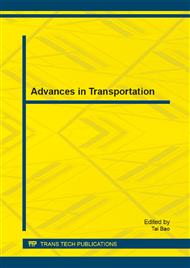p.731
p.735
p.740
p.745
p.750
p.755
p.759
p.767
p.778
The Road Network Density and Spatial Dependence Analysis Based on Basin Scale - A Case Study on Shiyang River Basin
Abstract:
Taking Shiyang River Basin as study area, Considering that the road net building is influenced by the industry, structure of resources, the road building policy, the highway net construction policies and the other transport patterns, so a concept of highway dependence-preference index is put forward, which is used to explain the variation between the actually obtained highway net densities and the values obtained by model calculation. The results show that:The density of road network in Shiyang River Basin is outward decay along the center of Jinchang and Wuwei City. The distribution density of road network is zonal shape from the south of Tianzhu county extending to the Jinchuan District, Jinchang City. Social developments of the Shiyang River Basin depend on the road network strongly, with two Counties/Districts in the super dependence or super preference situation, 28 towns in strong dependence or strong preference situation, which accounting for 26.67% of all townships in Shiyang River Basin. The medium dependence or medium preference situation is about 44 towns, which accounting for 41.9% of all counties in Shiyang River Basin. 24 countries/districts are in the less dependent or weak preference, and 7 countries/districts are in the weak dependent or weak preference situation. Besides, the study also found that the counties city center also formed basically a small group of road network, the region and part of key towns may become a potential area of the density of road network development in the future.
Info:
Periodical:
Pages:
750-754
Citation:
Online since:
January 2014
Authors:
Price:
Сopyright:
© 2014 Trans Tech Publications Ltd. All Rights Reserved
Share:
Citation:


